2014 HYUNDAI COUPE warning
[x] Cancel search: warningPage 3 of 546
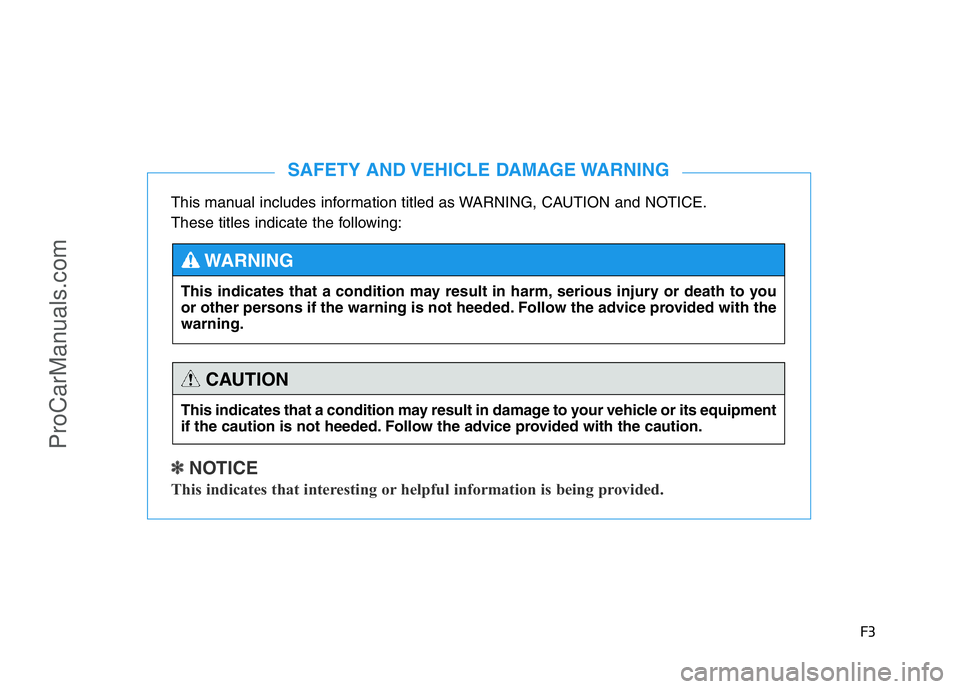
F3
This manual includes information titled as WARNING, CAUTION and NOTICE.
These titles indicate the following:
✽ NOTICE
This indicates that interesting or helpful information is being provided.
SAFETY AND VEHICLE DAMAGE WARNING
This indicates that a condition may result in harm, serious injury or death to you
or other persons if the warning is not heeded. Follow the advice provided with the
warning.
WARNING
This indicates that a condition may result in damage to your vehicle or its equipment
if the caution is not heeded. Follow the advice provided with the caution.
CAUTION
ProCarManuals.com
Page 5 of 546
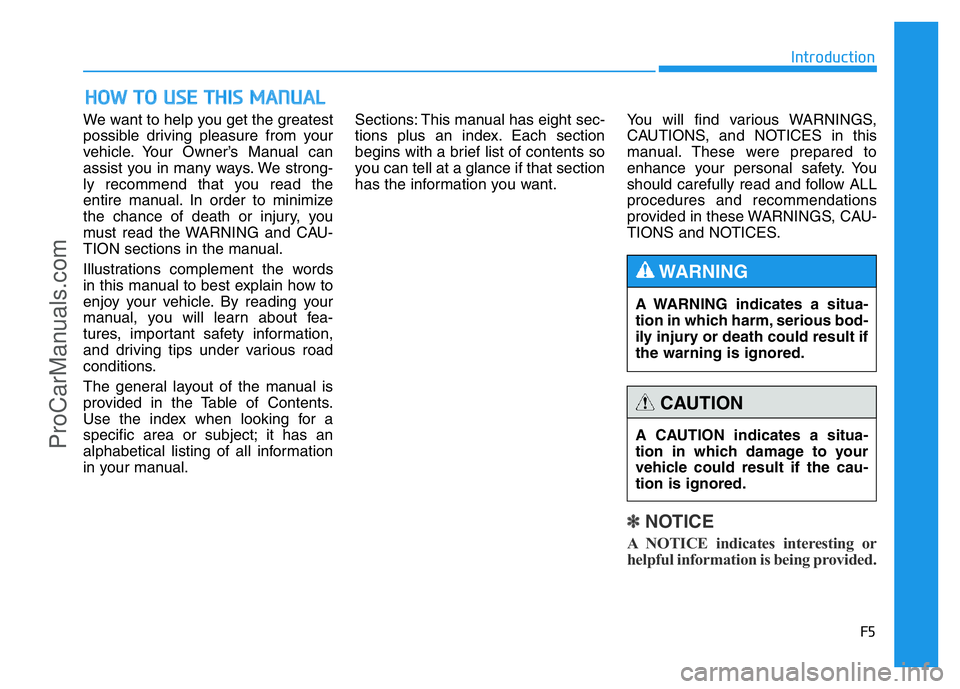
We want to help you get the greatest
possible driving pleasure from your
vehicle. Your Owner’s Manual can
assist you in many ways. We strong-
ly recommend that you read the
entire manual. In order to minimize
the chance of death or injury, you
must read the WARNING and CAU-
TION sections in the manual.
Illustrations complement the words
in this manual to best explain how to
enjoy your vehicle. By reading your
manual, you will learn about fea-
tures, important safety information,
and driving tips under various road
conditions.
The general layout of the manual is
provided in the Table of Contents.
Use the index when looking for a
specific area or subject; it has an
alphabetical listing of all information
in your manual.Sections: This manual has eight sec-
tions plus an index. Each section
begins with a brief list of contents so
you can tell at a glance if that section
has the information you want.You will find various WARNINGS,
CAUTIONS, and NOTICES in this
manual. These were prepared to
enhance your personal safety. You
should carefully read and follow ALL
procedures and recommendations
provided in these WARNINGS, CAU-
TIONS and NOTICES.
✽ NOTICE
A NOTICE indicates interesting or
helpful information is being provided.
HOW TO USE THIS MANUAL
A WARNING indicates a situa-
tion in which harm, serious bod-
ily injury or death could result if
the warning is ignored.
WARNING
A CAUTION indicates a situa-
tion in which damage to your
vehicle could result if the cau-
tion is ignored.
CAUTION
F5
Introduction
ProCarManuals.com
Page 6 of 546
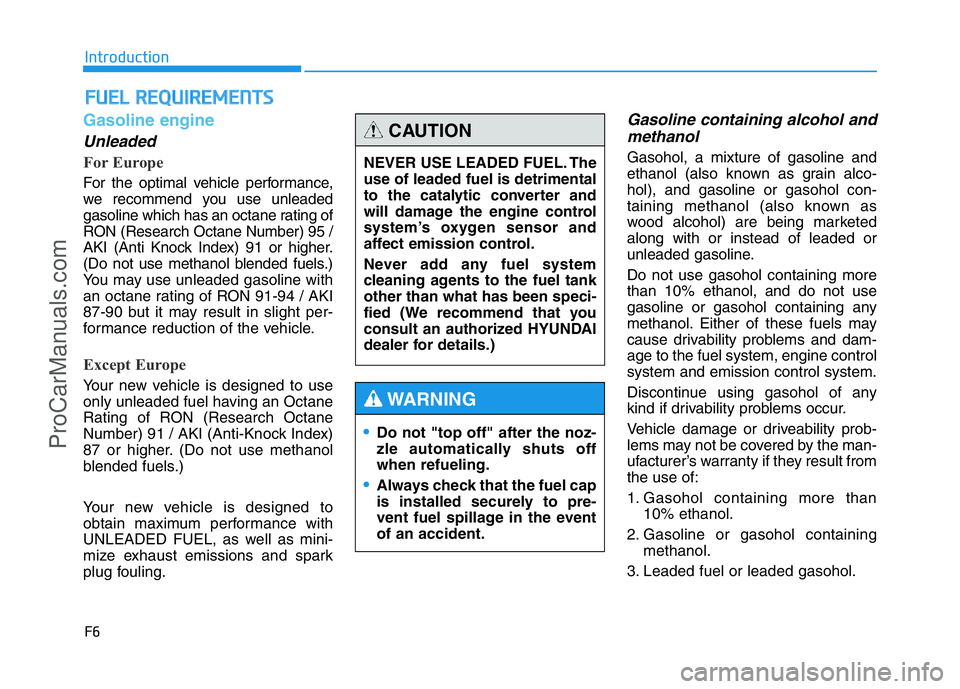
F6
Introduction
Gasoline engine
Unleaded
For Europe
For the optimal vehicle performance,
we recommend you use unleaded
gasoline which has an octane rating of
RON (Research Octane Number) 95 /
AKI (Anti Knock Index) 91 or higher.
(Do not use methanol blended fuels.)
You may use unleaded gasoline with
an octane rating of RON 91-94 / AKI
87-90 but it may result in slight per-
formance reduction of the vehicle.
Except Europe
Your new vehicle is designed to use
only unleaded fuel having an Octane
Rating of RON (Research Octane
Number) 91 / AKI (Anti-Knock Index)
87 or higher. (Do not use methanol
blended fuels.)
Your new vehicle is designed to
obtain maximum performance with
UNLEADED FUEL, as well as mini-
mize exhaust emissions and spark
plug fouling.
Gasoline containing alcohol and
methanol
Gasohol, a mixture of gasoline and
ethanol (also known as grain alco-
hol), and gasoline or gasohol con-
taining methanol (also known as
wood alcohol) are being marketed
along with or instead of leaded or
unleaded gasoline.
Do not use gasohol containing more
than 10% ethanol, and do not use
gasoline or gasohol containing any
methanol. Either of these fuels may
cause drivability problems and dam-
age to the fuel system, engine control
system and emission control system.
Discontinue using gasohol of any
kind if drivability problems occur.
Vehicle damage or driveability prob-
lems may not be covered by the man-
ufacturer’s warranty if they result from
the use of:
1. Gasohol containing more than
10% ethanol.
2. Gasoline or gasohol containing
methanol.
3. Leaded fuel or leaded gasohol.
FUEL REQUIREMENTS
•Do not "top off" after the noz-
zle automatically shuts off
when refueling.
•Always check that the fuel cap
is installed securely to pre-
vent fuel spillage in the event
of an accident.
WARNING
NEVER USE LEADED FUEL. The
use of leaded fuel is detrimental
to the catalytic converter and
will damage the engine control
system’s oxygen sensor and
affect emission control.
Never add any fuel system
cleaning agents to the fuel tank
other than what has been speci-
fied (We recommend that you
consult an authorized HYUNDAI
dealer for details.)
CAUTION
ProCarManuals.com
Page 15 of 546
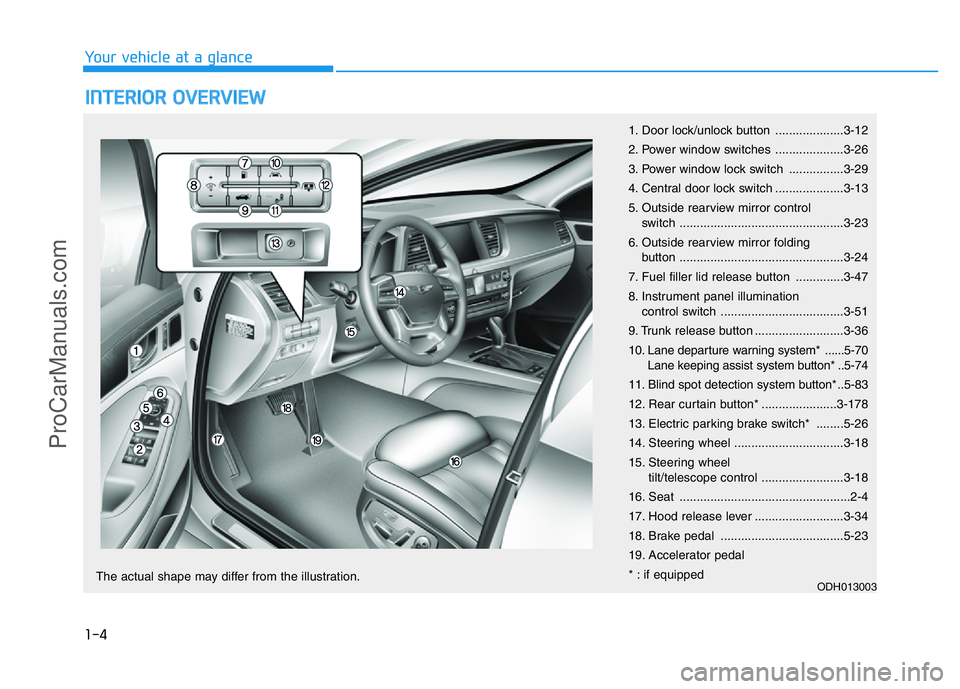
1-4
Your vehicle at a glance
INTERIOR OVERVIEW
1. Door lock/unlock button ....................3-12
2. Power window switches ....................3-26
3. Power window lock switch ................3-29
4. Central door lock switch ....................3-13
5. Outside rearview mirror control
switch ................................................3-23
6. Outside rearview mirror folding
button ................................................3-24
7. Fuel filler lid release button ..............3-47
8. Instrument panel illumination
control switch ....................................3-51
9. Trunk release button ..........................3-36
10. Lane departure warning system* ......5-70
Lane keeping assist system button* ..5-74
11. Blind spot detection system button* ..5-83
12. Rear curtain button* ......................3-178
13. Electric parking brake switch* ........5-26
14. Steering wheel ................................3-18
15. Steering wheel
tilt/telescope control ........................3-18
16. Seat ..................................................2-4
17. Hood release lever ..........................3-34
18. Brake pedal ....................................5-23
19. Accelerator pedal
* : if equipped
ODH013003The actual shape may differ from the illustration.
ProCarManuals.com
Page 19 of 546
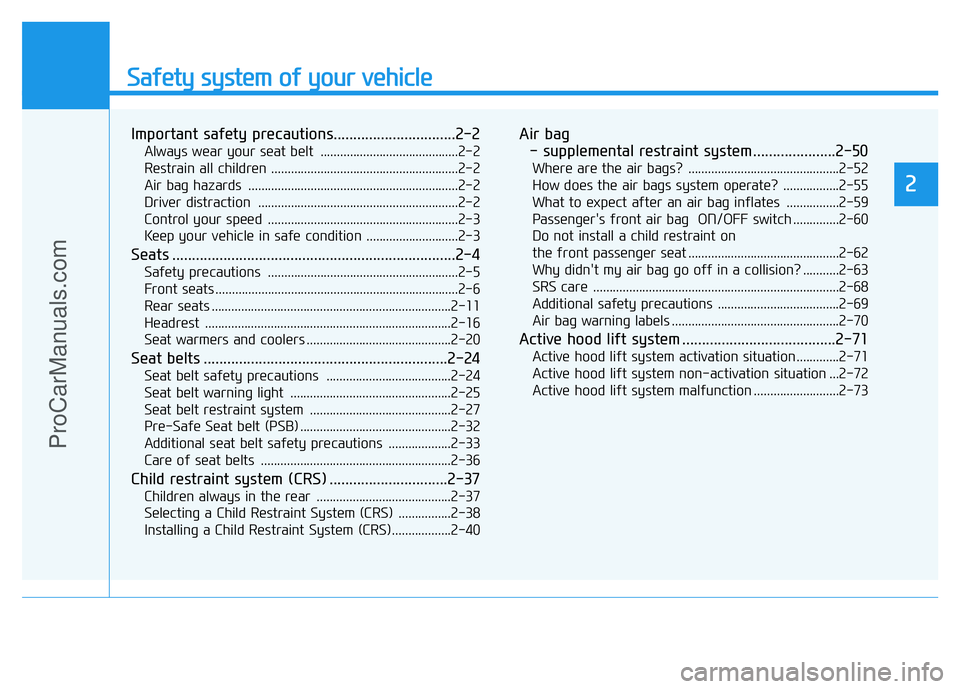
Safety system of your vehicle
2
Important safety precautions...............................2-2
Always wear your seat belt ..........................................2-2
Restrain all children .........................................................2-2
Air bag hazards ................................................................2-2
Driver distraction .............................................................2-2
Control your speed ..........................................................2-3
Keep your vehicle in safe condition ............................2-3
Seats ........................................................................2-4
Safety precautions ..........................................................2-5
Front seats ..........................................................................2-6
Rear seats .........................................................................2-11
Headrest ...........................................................................2-16
Seat warmers and coolers ............................................2-20
Seat belts ..............................................................2-24
Seat belt safety precautions ......................................2-24
Seat belt warning light .................................................2-25
Seat belt restraint system ...........................................2-27
Pre-Safe Seat belt (PSB) ..............................................2-32
Additional seat belt safety precautions ...................2-33
Care of seat belts ..........................................................2-36
Child restraint system (CRS) ..............................2-37
Children always in the rear .........................................2-37
Selecting a Child Restraint System (CRS) ................2-38
Installing a Child Restraint System (CRS)..................2-40
Air bag
- supplemental restraint system.....................2-50
Where are the air bags? ..............................................2-52
How does the air bags system operate? .................2-55
What to expect after an air bag inflates ................2-59
Passenger's front air bag ON/OFF switch ..............2-60
Do not install a child restraint on
the front passenger seat ..............................................2-62
Why didn't my air bag go off in a collision? ...........2-63
SRS care ...........................................................................2-68
Additional safety precautions .....................................2-69
Air bag warning labels ...................................................2-70
Active hood lift system .......................................2-71
Active hood lift system activation situation .............2-71
Active hood lift system non-activation situation ...2-72
Active hood lift system malfunction ..........................2-73
ProCarManuals.com
Page 20 of 546

2-2
You will find many safety precautions
and recommendations throughout
this section, and throughout this man-
ual. The safety precautions in this sec-
tion are among the most important.
Always wear your seat belt
A seat belt is your best protection in
all types of accidents. Air bags are
designed to supplement seat belts,
not replace them. So even though
your vehicle is equipped with air bags,
ALWAYS make sure you and your
passengers wear your seat belts, and
wear them properly.
Restrain all children
All children under age 13 should ride
in your vehicle properly restrained in
a rear seat, not the front seat. Infants
and small children should be
restrained in an appropriate child
restraint. Larger children should use
a booster seat with the lap/shoulder
belt until they can use the seat belt
properly without a booster seat.
Air bag hazards
While air bags can save lives, they
can also cause serious or fatal
injuries to occupants who sit too
close to them, or who are not prop-
erly restrained. Infants, young chil-
dren, and short adults are at the
greatest risk of being injured by an
inflating air bag. Follow all instruc-
tions and warnings in this manual.
Driver distraction
Driver distraction presents a serious
and potentially deadly danger, espe-
cially for inexperienced drivers. Safety
should be the first concern when
behind the wheel and drivers need to
be aware of the wide array of potential
distractions, such as drowsiness,
reaching for objects, eating, personal
grooming, other passengers, and
using cellular phones.
Drivers can become distracted when
they take their eyes and attention off
the road or their hands off the wheel
to focus on activities other than driv-
ing. To reduce your risk of distraction
and an accident:
• ALWAYS set up your mobile devices
(i.e., MP3 players, phones, naviga-
tion units, etc.) when your vehicle is
parked or safely stopped.
• ONLY use your mobile device when
allowed by laws and conditions per-
mit safe use. NEVER text or email
while driving. Most countries have
laws prohibiting drivers from texting.
Some countries and cities also pro-
hibit drivers from using handheld
phones.
IMPORTANT SAFETY PRECAUTIONS
Safety system of your vehicle
ProCarManuals.com
Page 23 of 546

To reduce the risk of serious
injury or death from an inflating
air bag, take the following pre-
cautions:
•Adjust the driver’s seat as far
to the rear as possible while
maintaining the ability to main-
tain full control of the vehicle.
•Adjust the front passenger
seat as far to the rear as possi-
ble.
(Continued)
WARNING
(Continued)
•Hold the steering wheel by the
rim with hands at the 9 o’clock
and 3 o’clock positions to min-
imize the risk of injuries to
your hands and arms.
•NEVER place anything or any-
one between the air bag.
•Do not allow the front passen-
ger to place feet or legs on the
dashboard to minimize the risk
of leg injuries.
2-5
Safety system of your vehicle
2
Safety precautions
Adjusting the seats so that you are sit-
ting in a safe, comfortable position
plays an important role in driver and
passenger safety together with the
seat belts and air bags in an accident.
Air bags
You can take steps to reduce the risk
of being injured by an inflating air bag.
Sitting too close to an air bag greatly
increases the risk of injury in the
event the air bag inflates. It is recom-
mended that drivers allow at least 25
cm (10 inches) between the center of
the steering wheel and their chest.
Do not use a cushion that
reduces friction between the seat
and the passenger. The passen-
ger's hips may slide under the
lap portion of the seat belt during
an accident or a sudden stop.
Serious or fatal internal injuries
could result because the seat
belt cannot operate properly.
WARNING
ProCarManuals.com
Page 24 of 546
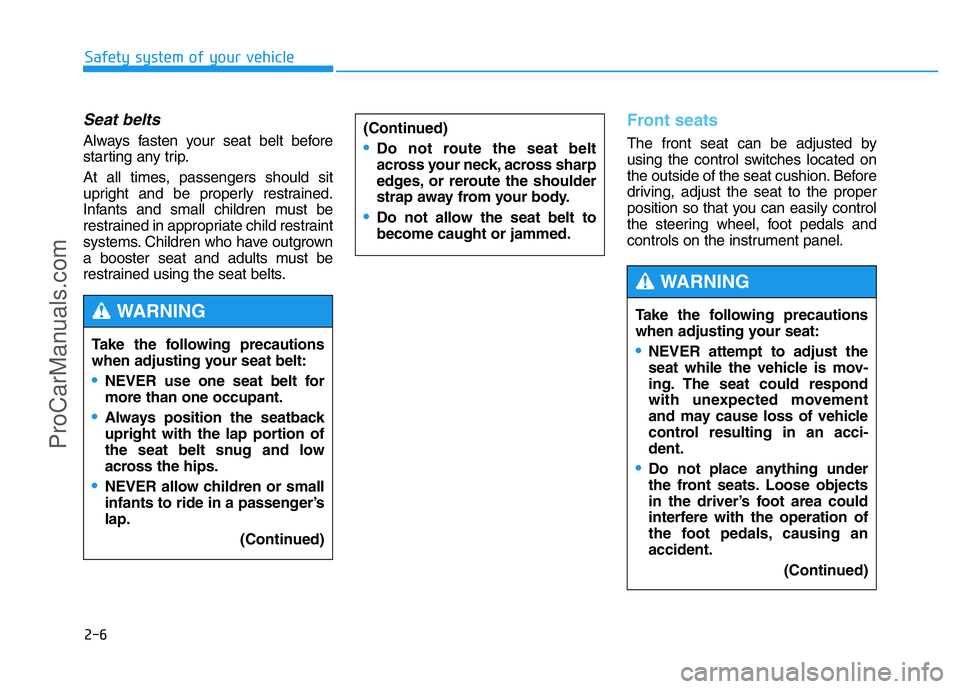
2-6
Safety system of your vehicle
Seat belts
Always fasten your seat belt before
starting any trip.
At all times, passengers should sit
upright and be properly restrained.
Infants and small children must be
restrained in appropriate child restraint
systems. Children who have outgrown
a booster seat and adults must be
restrained using the seat belts.
Front seats
The front seat can be adjusted by
using the control switches located on
the outside of the seat cushion. Before
driving, adjust the seat to the proper
position so that you can easily control
the steering wheel, foot pedals and
controls on the instrument panel.
Take the following precautions
when adjusting your seat belt:
•NEVER use one seat belt for
more than one occupant.
•Always position the seatback
upright with the lap portion of
the seat belt snug and low
across the hips.
•NEVER allow children or small
infants to ride in a passenger’s
lap.
(Continued)
(Continued)
•Do not route the seat belt
across your neck, across sharp
edges, or reroute the shoulder
strap away from your body.
•Do not allow the seat belt to
become caught or jammed.
WARNING Take the following precautions
when adjusting your seat:
•NEVER attempt to adjust the
seat while the vehicle is mov-
ing. The seat could respond
with unexpected movement
and may cause loss of vehicle
control resulting in an acci-
dent.
•Do not place anything under
the front seats. Loose objects
in the driver’s foot area could
interfere with the operation of
the foot pedals, causing an
accident.
(Continued)
WARNING
ProCarManuals.com